In the previous sequel of my travel stories, where I talked about my walk through the Siq in Petra, it was possible to see in some of the photos parts of the ancient paved road. Now let me say something about it.
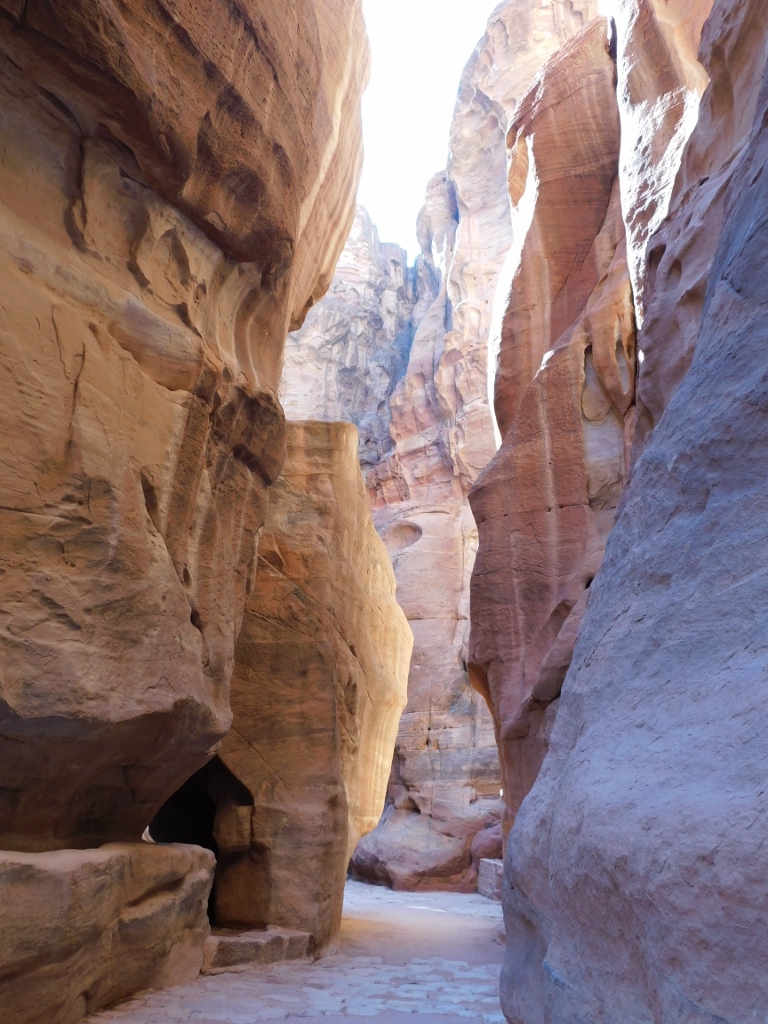 Petra, the Siq, towards the bottom you can see a part of the paved road
Petra, the Siq, towards the bottom you can see a part of the paved road
Since the Siq is a natural formation, created by the tectonic separation of rocks that were only afterwards shaped by the wind and the water, the bottom of this gorge was originally covered in gravel. However, as the researchers have ascertained, around the middle of the 1st century BCE there were some major flash floods that created havoc here. Because of this, the Nabataeans decided to take things into their own hands. One of these things was the paving of the road using limestone slabs and that work was finished around 30 to 20 BCE. Parts of that paved road may be seen even today.
Another very important engineering enterprise of the Nabataeans in the Siq was to close off the side gorges by dams; more accurately, five such gorges. The reason for that were again the flash floods that can be formed within a short period of time when there is a lot of rainfall. Because, when a large quantity of water starts flowing along narrow pathways, it gains in strength and can eventually have very destructive action.
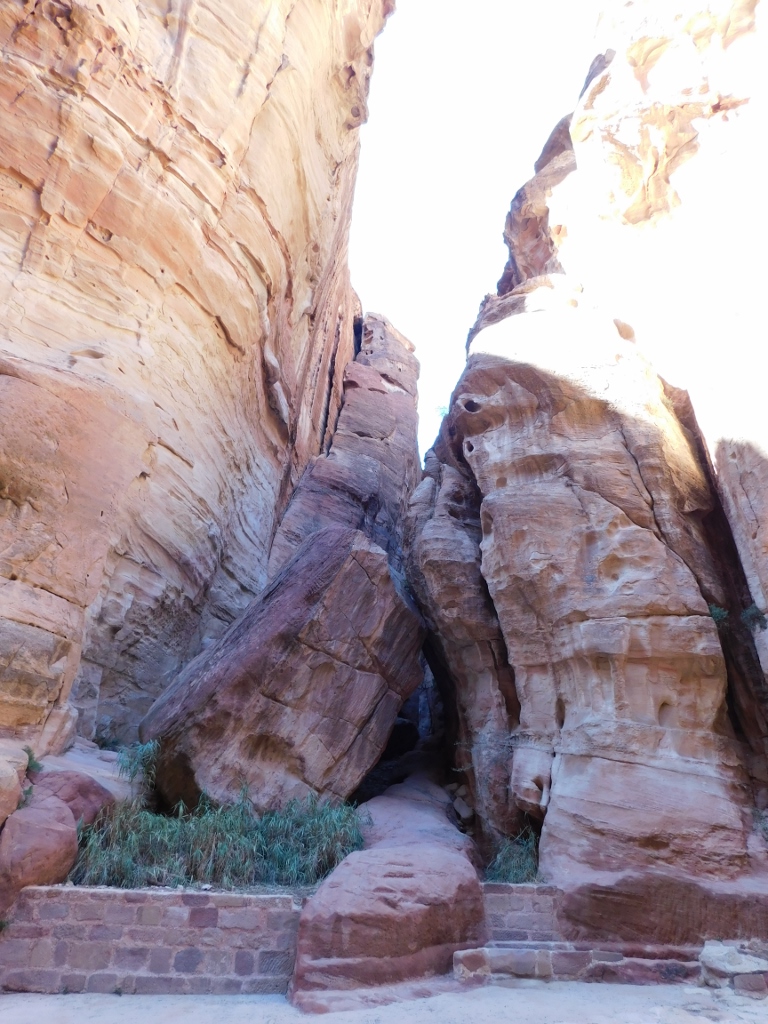 Petra, the Siq, example of a side gorge, but I presume this one is not dangerous
Petra, the Siq, example of a side gorge, but I presume this one is not dangerous
Nowadays, these gorges are closed off by repaired and consolidated dams, not by the original Nabataean ones, but these dams certainly provide a good picture of how the Nabataeans thought of this first.
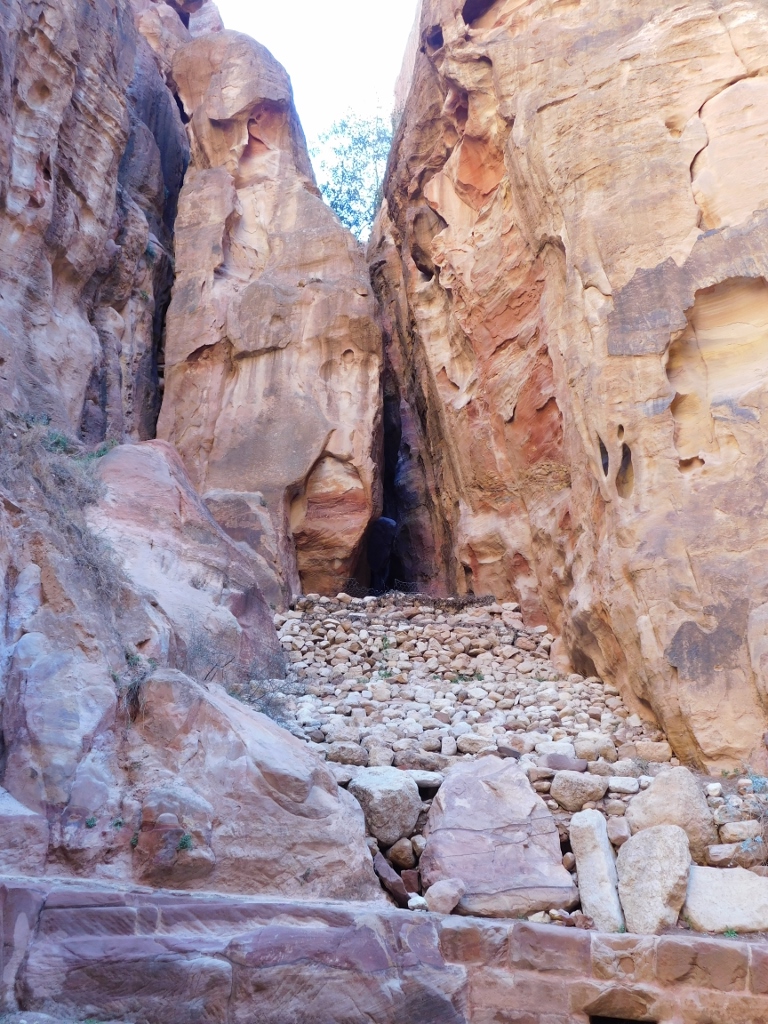 Petra, the Siq, a closed off side gorge
Petra, the Siq, a closed off side gorge
According to what I have read, there is yet another reason for the building of these dams within the side gorges and that is that people can practically enter and exit the Siq only at its two respective ends and in no other way, since these dams prevent passage. Between the entry and exit points, one needs to cover those 1.2 km.
And, finally, when the Nabataeans worked on the Siq in the 1st century BCE, in addition to that complex protective system, they made water channels in the rock and they also placed terracotta pipes on the north side of the Siq. Using this system, they brought drinking water from Moses spring, locally called Ain Musa, to the city. However, in 363 CE, Petra was struck by a devastating earthquake and after that only the water channel on the south side of the Siq was repaired. Remains of this Nabataeans version of the waterworks can be seen in the Siq even today.
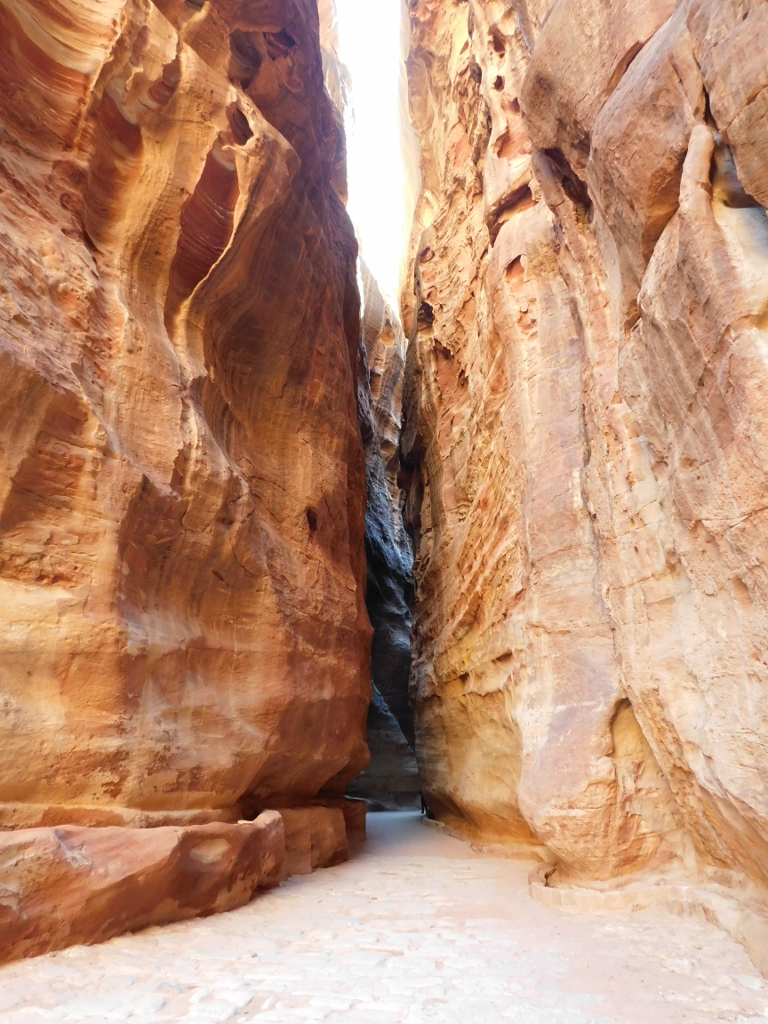 Petra, the Siq, on the left-hand side there is the water channel made in the rock (more detailed photos can be seen in the previous sequel of my travel stories)
Petra, the Siq, on the left-hand side there is the water channel made in the rock (more detailed photos can be seen in the previous sequel of my travel stories)
There are a few narrow sections of the gorge, such as the one seen in the photo above, and when I reached one of them I made a couple of photos in order to show the view up. One photo focuses on the rocks and the other one on the sky.
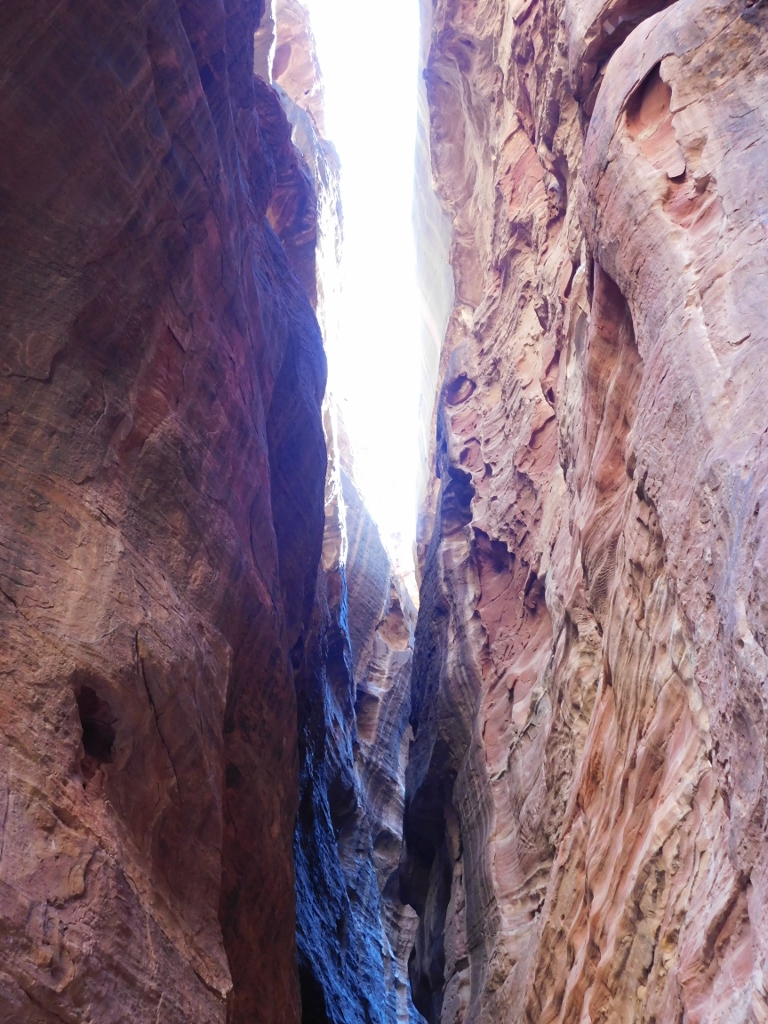 Petra, the Siq, a detail
Petra, the Siq, a detail
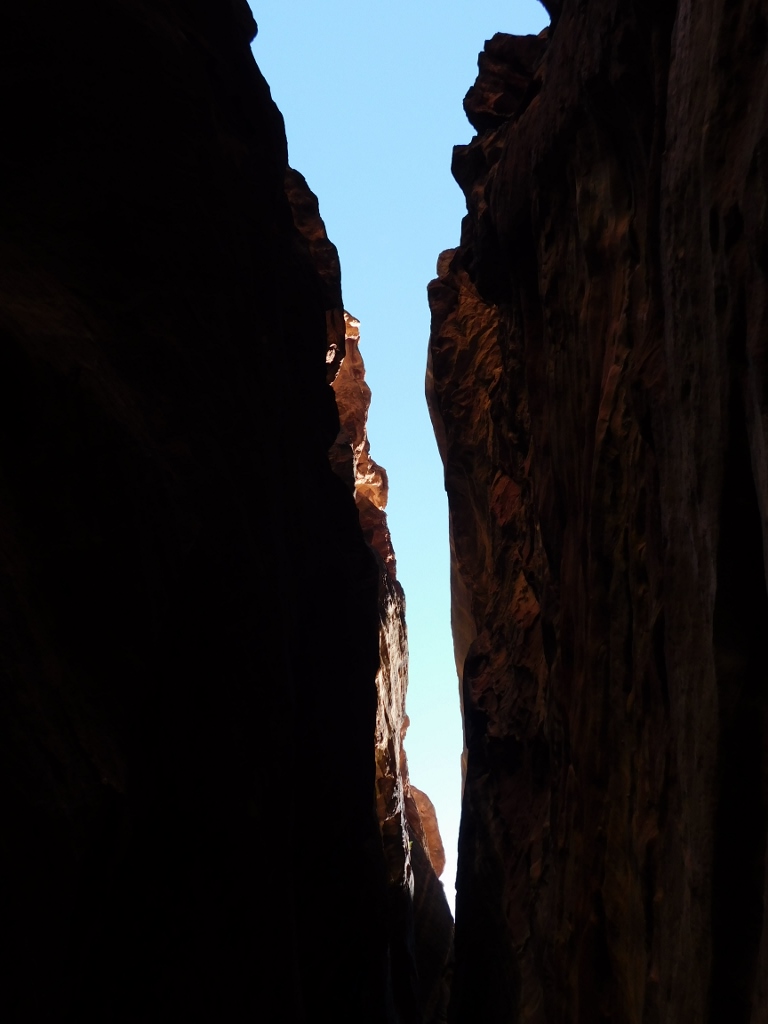 Petra, the Siq, a detail
Petra, the Siq, a detail
In one of such places, where I was completely alone, I just felt like singing. The main reason for that was that the acoustics was incredible. Depending on the device on which you listen to this, the acoustics may be heard well or perhaps not. The video on my mobile phone is – absolutely fantastic. This is also an opportunity to post my Mlog no. 6. For those who are not familiar with the song, this is a 20th century Serbian song with a traditional melody.
After the mini-concert I continued with the walk and here is again a short video about this. Here at the beginning, you can see well a part of the paved road that I have already written about and it is often possible to see the incredible red hues of the rocks that are characteristic of Petra.
At the end of the previous video, I approached an important place where I made a stop. It is Sabinos Alexandros Station. This is in fact a number of votive niches. They were made in the 2nd/3rd century CE, which means after the end of the Nabataean Kingdom that took place in 106 CE. The last niche that can be dated reliably was made in 256. Here it is possible to see numerous donor inscriptions and one of the donors was a Sabinos Alexandros, hence the name of this cult site. Here is a photograph, too:
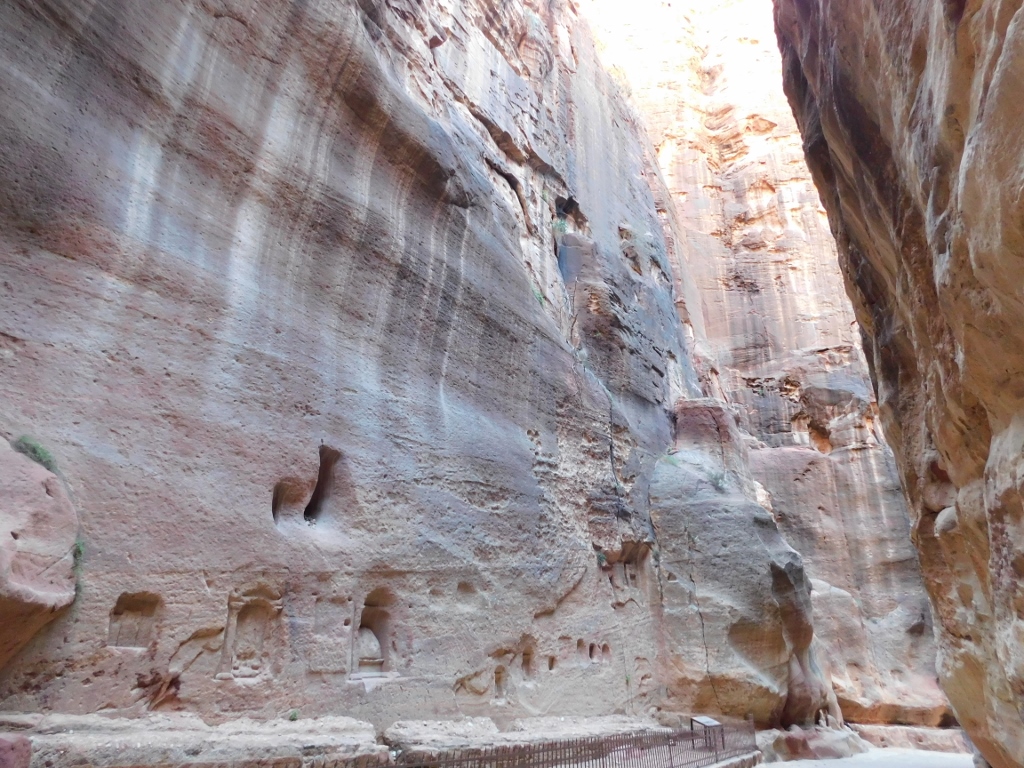 Petra, the Siq, Sabinos Alexandros Station
Petra, the Siq, Sabinos Alexandros Station
When you look on the left-hand side, in the first niche there are three betyls or sacred stones, this is followed by an aedicula, an arched niche with a betyl and a sequence of smaller votive niches (I have explained all of these terms in the previous sequel of my travel stories).
Right after Sabinos Alexandros Station, on the south side of the Siq, comes a very interesting relief composition of Camel Caravan. In fact, these are remains of two reliefs, since most of them have disappeared because of the erosive action. The data says that it contains depictions of groups of camels and people, one group just coming to Petra, the other one leaving it. These two reliefs are situated some dozen metres farther from the Station and they are separated, among other things, by a narrow and high natural cut through which water flows during rainfall.
The first relief you come across is better preserved and therefore it is more picturesque. Here it is in the photo below:
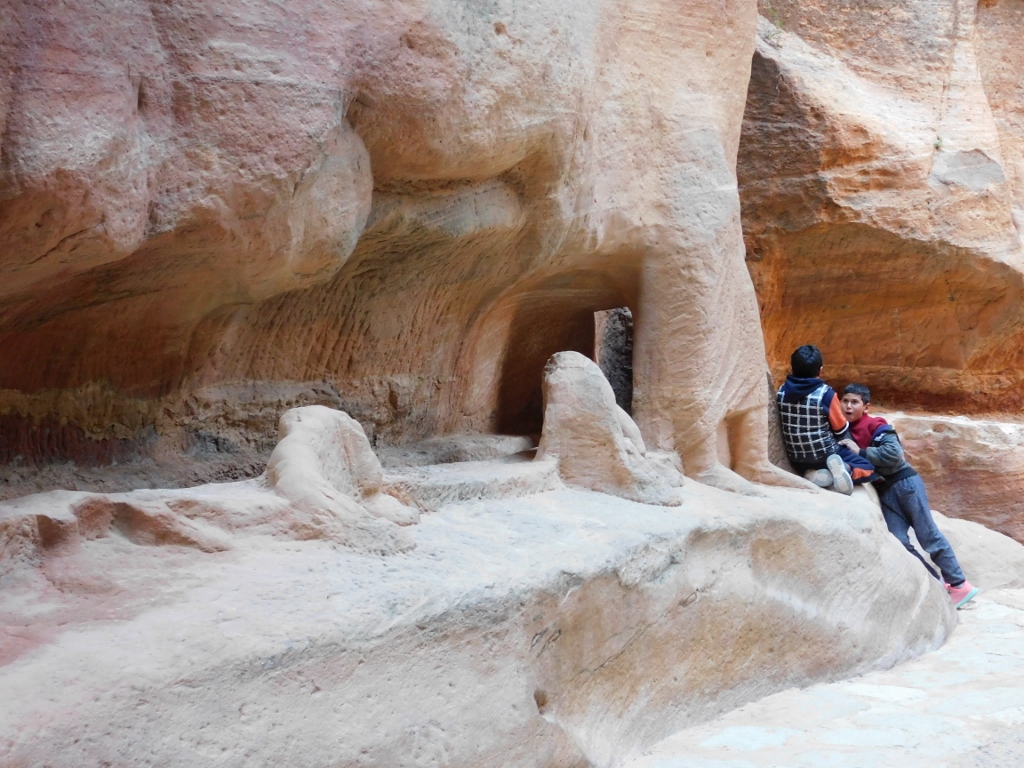 Petra, the Siq, the Camel Caravan, better preserved section
Petra, the Siq, the Camel Caravan, better preserved section
In addition to the two boys in the photo, you can also discern the lower part of the body of a man leading camels, dressed in clothes that were at some point in time typical of Egyptians. It is interesting that the reliefs were made in such a way that the legs both of the man and the camels were separated from the rock wall by the water channel. My photo does not show well the details of the camels’ feet that can be seen on the two upright rock segments that have no connection with the upper section. (Originally, there used to be proper camel legs made of rock, but they have disappeared because of the erosion.) In the upper section it is possible to discern the stomach of the camel and its legs. And, where the boys are sitting starts that natural cut in the cliff where rainfall flows.
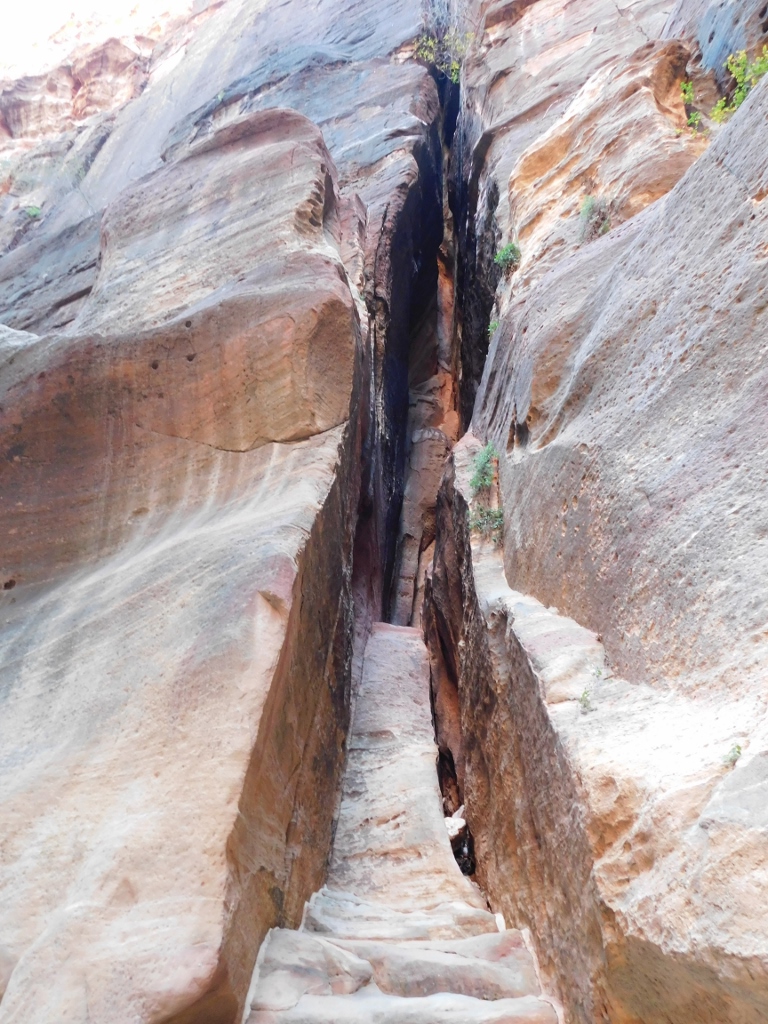 Petra, the Siq, the natural cut in the rock beside the Camel Caravan
Petra, the Siq, the natural cut in the rock beside the Camel Caravan
Some dozen metres further, there is another Camel Caravan, but that one has eroded even more and one needs to look very carefully in order to notice some details. In the photo below, on the left-hand side, you may perhaps discern the legs and stomachs of two camels.
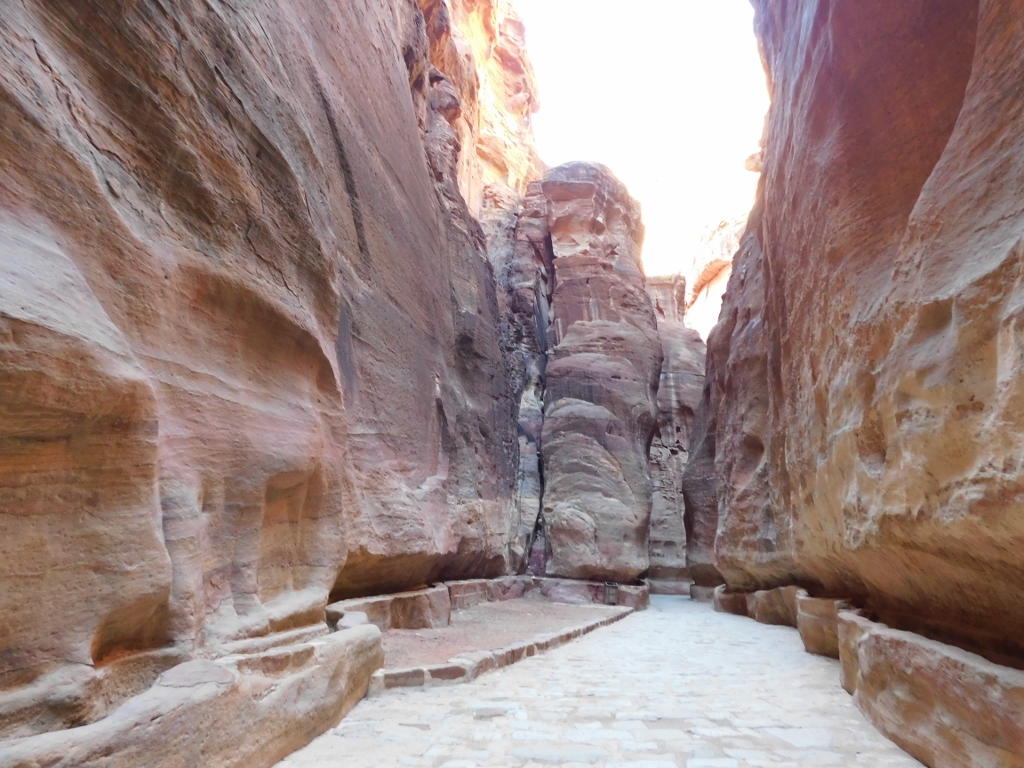 Petra, the Siq, Camel Caravan, the more poorly preserved segment
Petra, the Siq, Camel Caravan, the more poorly preserved segment
Regardless of their current state, these reliefs are very important because they symbolise the endless caravans that brought people and goods to Petra and carried them away from here. Because, the economy of Petra and its riches and development were based precisely on trade. I think this is also a good moment for me to say a few things about Nabataeans and their kingdom.
The Nabataeans were an Arabic nation that inhabited north Arabia and south Levant (by the way, term Levant is generally used to designate collectively the countries that are located along the east coast of the Mediterranean). The Nabataeans were first mentioned in 647 BCE and at that time they were one of several Bedouin nomadic tribes. In line with that, they regularly roamed the Arabian Desert searching for water and grazing ground for their animals. Over time, they moved to the territory of the Kingdom of Edom, since the inhabitants of that kingdom moved more to the west. Already from the 4th century BCE they appeared on the historic scene with their state and the capital Raqmu, i.e., the present-day Petra. At first, they continued living in the traditional Bedouin way and at that time the Nabataeans were ruled by an elders’ council. Later they switched to kings as their rulers and relatively quickly they saw the advantages of trade. Instead of attacking and robbing numerous caravans passing by, they realised that it was much more profitable to charge the caravans for providing them with safe passage through their territory. It also turned out that the valley in which Petra was located was an ideal place for doing business. The main goods transported by the caravans were frankincense, myrrh and spices.
The Nabataean Kingdom was very rich and consequently very attractive for conquerors. After the death of Alexander the Great, one of his generals (who continuously fought wars amongst themselves trying to grab as much territories left after Alexander’s death), Antigonus I Monophthalmus, attacked the Nabataean Kingdom a couple of times. The first time, in 312 BCE, the Nabataean men were at some religious festival, while the Greeks apparently rushed into Petra where only women, children and the elderly were there at the time, robbing tons of spices, silver, incense and myrrh. However, the Greeks got relaxed, not expecting a swift reaction on the part of the Nabataeans, who actually caught up with them and killed over 4000 Greek soldiers. Only 50 Greek cavalry men survived by fleeing away. The Nabataeans got their wealth back and returned to their city, sending a letter of sorts to Antigonus I in which they claimed that whatever happened was an act of self-defence.
Of course, everything was clear to everybody, but probably Antigonus I could not gather a large army right away, so he also sent a letter of sorts to the Nabataeans saying that he perfectly understood everything, that everything was fine and that the error lay with one of his officers (killed by the Nabataeans) who acted of his own accord.
However, soon enough, the Greeks headed for the Nabataean Kingdom again, but by this time the Nabataeans were ready – they had scouts and so they could on time hide their herds, valuables and goods across the surrounding area, in the well guarded, but difficult to access places, while a certain number of them remained to defend “the rock.” This is what the historic sources apparently say and when you put it all together it suggests that the attack was aimed right at Petra. The Greeks were led by Demetrius I Poliorcetes, son of Antigonus I Monophthalmus, who soon realised he could not prevail over the Nabataeans, so he accepted the peace offering and the gifts before withdrawing. This may suggest that the Nabataeans were so wealthy that they could buy their peace from the Greeks, but it can also be said that the Greek generals, as well as their offspring, fought so ferociously amongst themselves, that they had little time for others.
In any case, in the next two centuries, the Nabataeans expanded the territory of their kingdom and in 80 BCE they reached Damascus in the north. Much more importantly, they also enlarged their wealth because they were in the very centre of the roads that connected Egypt, Syria-Phoenicia and Arabia, while also being on the road that connected the Middle and East Asia, and the east Mediterranean. In addition to the previously mentioned goods, the trade also dealt with iron, copper and bitumen, while some sources also mention silk, glass, gold, silver, henna, etc. So, the trade flourished and the wealth of the Nabataeans kept growing.
In the meantime, the Roman Republic started to spread across the territory of Levant. Thus, in 62 BCE, during the reign of Nabataean king Aretas III (87-62 BCE), when the Nabataean Kingdom reached its territorial zenith, the Romans under the command of Scaurus conducted a siege of Petra, but the Nabataeans again got away by paying a certain amount to this Roman personally (this must have been an enormous sum for that time) and they also agreed to become a vassal and pay a tribute to the Roman Republic.
Although obviously freedom-loving people and although they resisted conquerors who wanted to subjugate them for a long period of time, finally in 106 CE, the Roman Empire annexed the Nabataean Kingdom. When eventually the Byzantines came here, the Nabataeans slowly converted into Christianity.
In January 2022, while walking through the Siq, I could see none of this drama and apart from some occasional sounds made by idle local inhabitants in their futile search for tourists, only the sound of my steps could be heard.
In the previous video, it is possible to see some of the important aspects of the Siq. One of them are the water channels that I have already mentioned before.
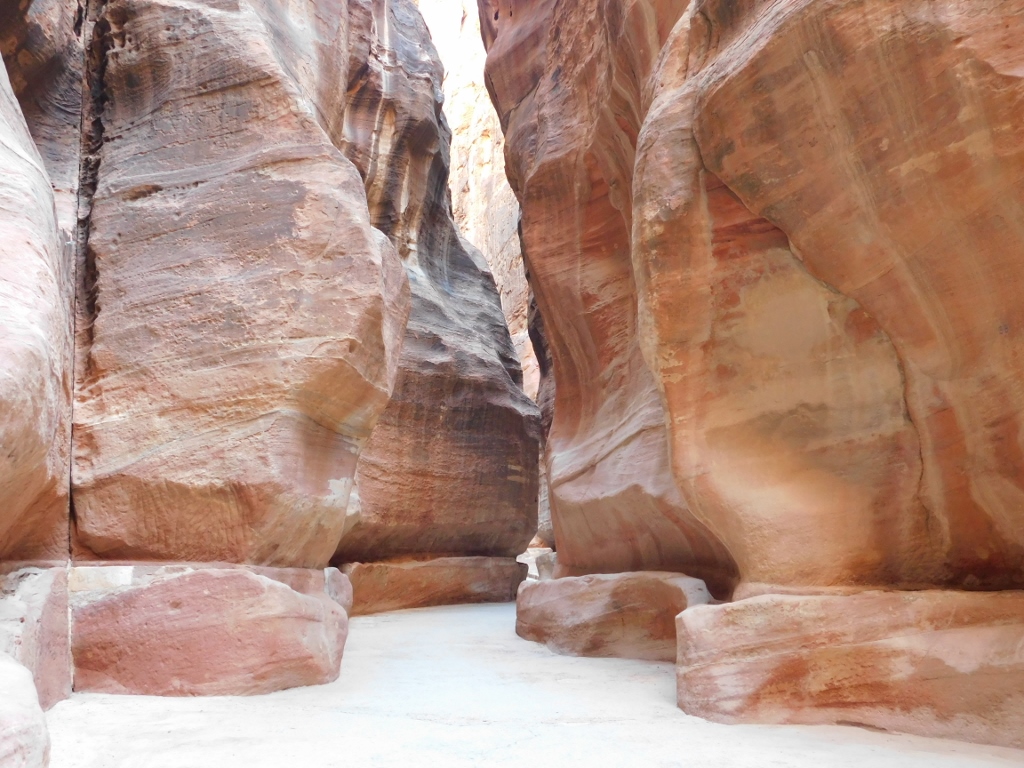 Petra, the Siq, details with water channels
Petra, the Siq, details with water channels
The water channel that runs along the south side of the Siq was covered by stone slabs back in the day (probably in order to keep the water clean). In addition, there were tanks in several places for the precipitation of limescales or other substances carried by the water. Also, along the Siq, there were several wells where it was possible to drink water.
The video also shows a couple of dams built in the transversal gorges in order to prevent the passage of flash floods into the Siq. I have written about this before as well and here is a photo.
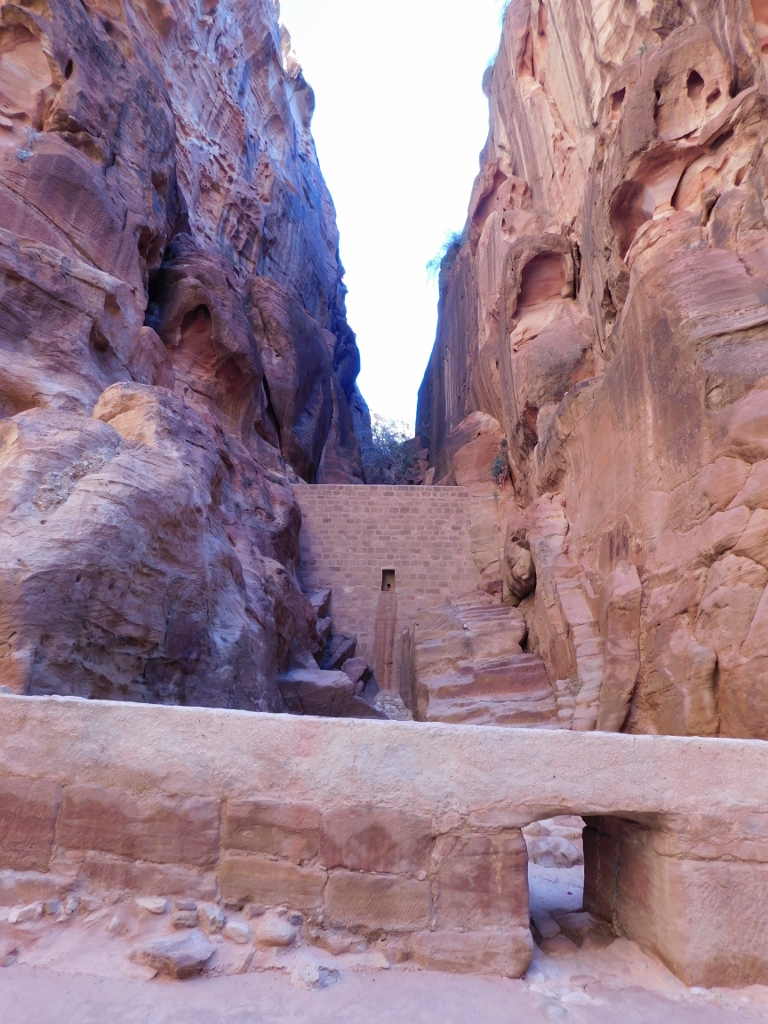 Petra, the Siq, dam in one of the transversal gorges
Petra, the Siq, dam in one of the transversal gorges
In the video it is also possible to see briefly a Bedouin sitting on a rock in the Siq. Perhaps his clothes, head scarf and kajal/kohl (black eyeliner) are traditional, but the footwear, as well as the mobile phone, are certainly not. On the other hand, just like the rest of the world, he is also mesmerised by the colourful screen of his device.
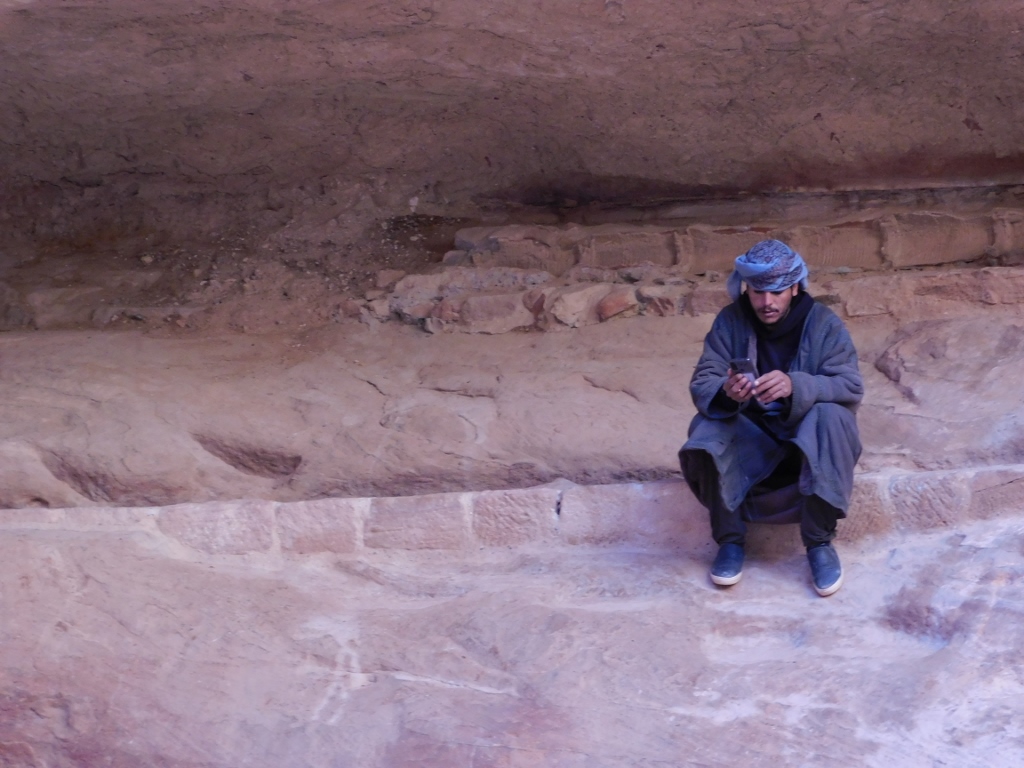 Petra, the Siq, modern Bedouin and his device
Petra, the Siq, modern Bedouin and his device
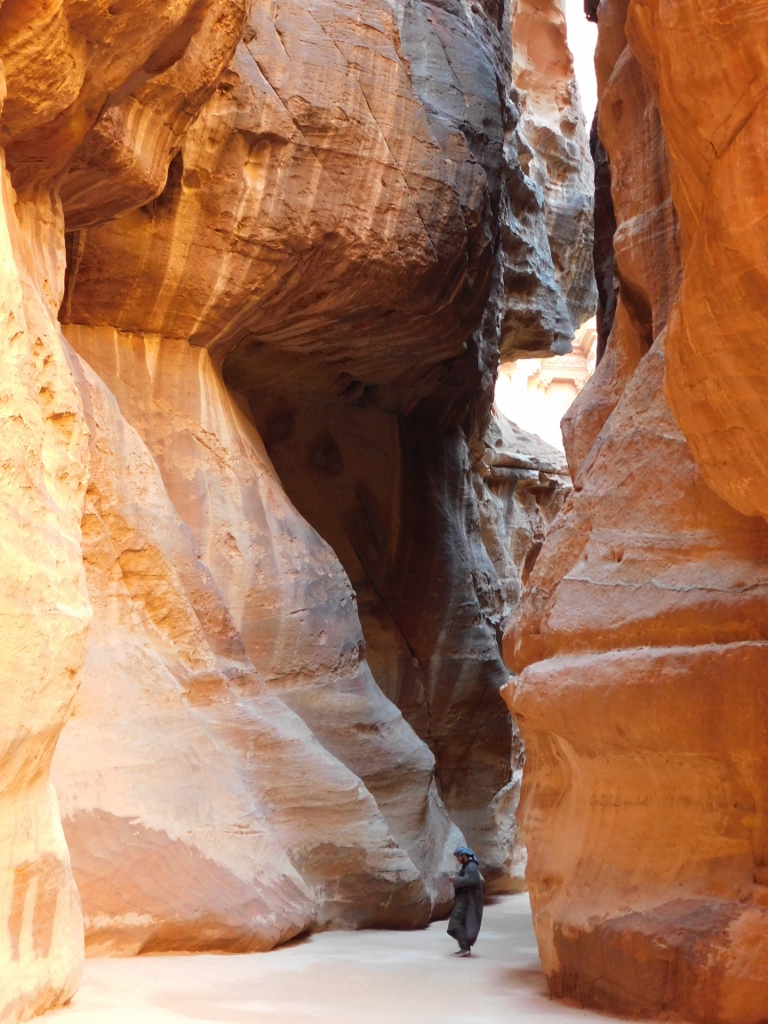 Petra, the Siq, the previous Bedouin is not alone in staring at a device
Petra, the Siq, the previous Bedouin is not alone in staring at a device
I must admit that it did not even occur to me to look at my mobile phone, for I was only interested in and fascinated by the specific beauty I was surrounded with.
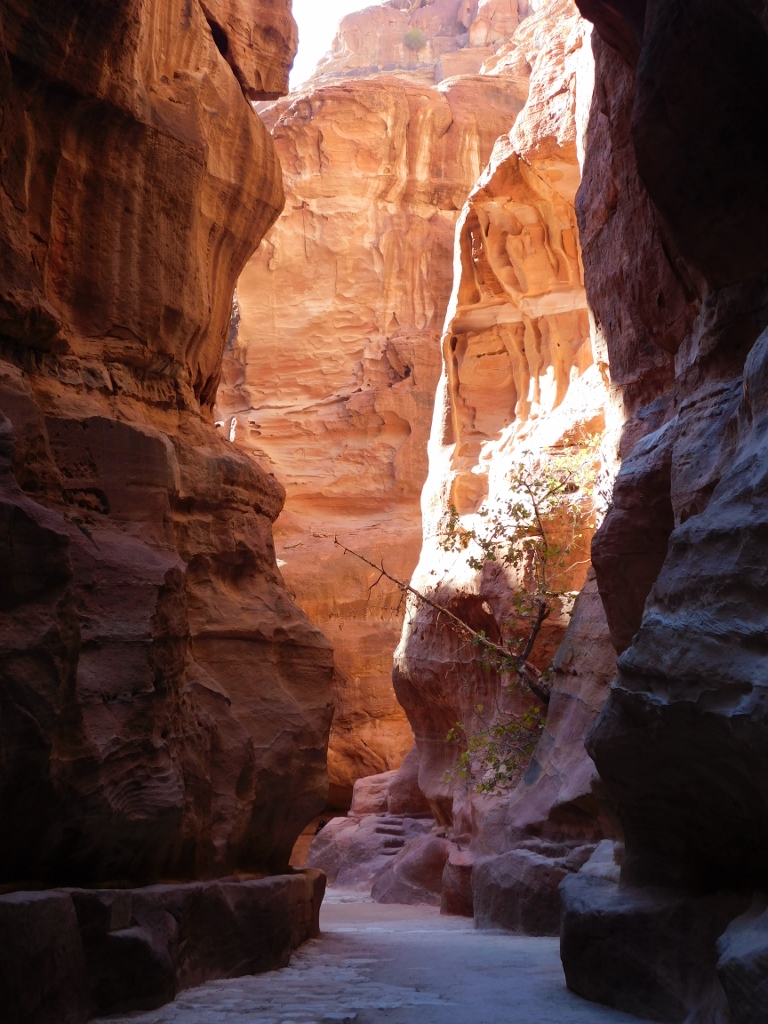 Petra, the Siq, details
Petra, the Siq, details
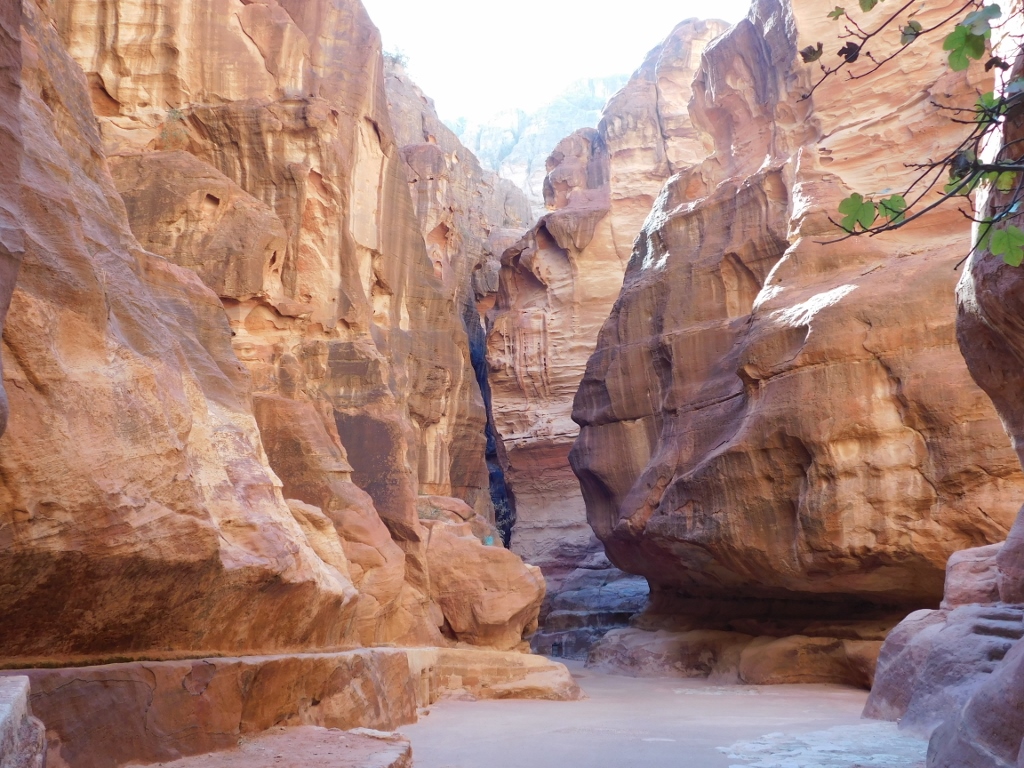 Petra, the Siq, details
Petra, the Siq, details
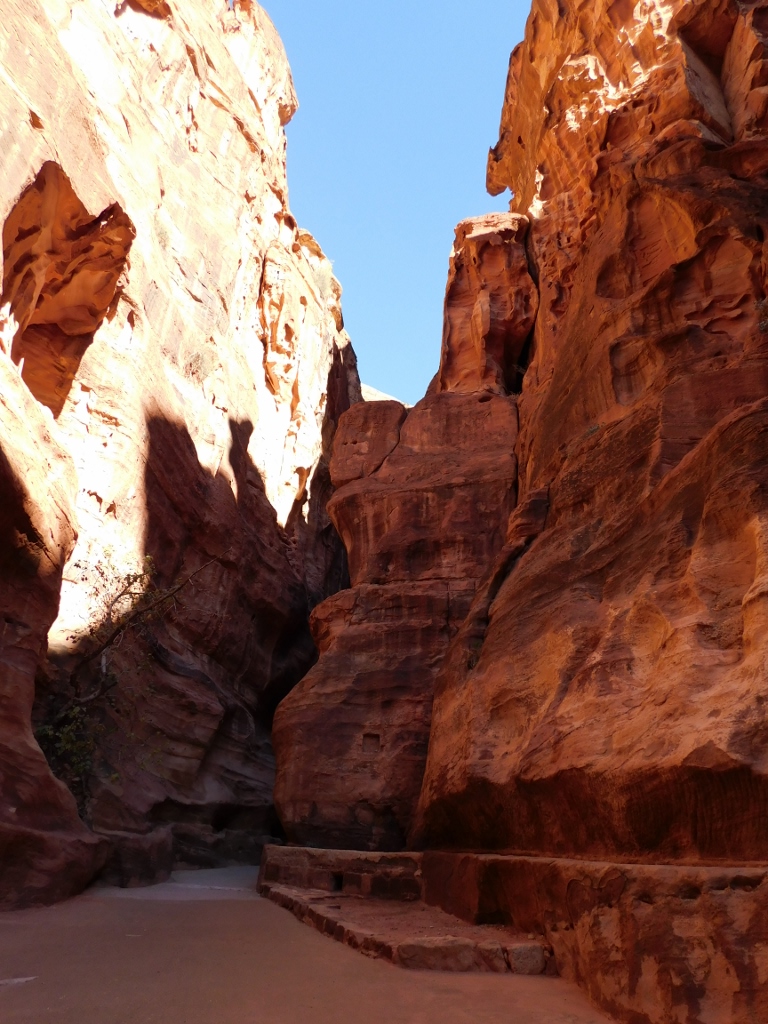 Petra, the Siq, details
Petra, the Siq, details
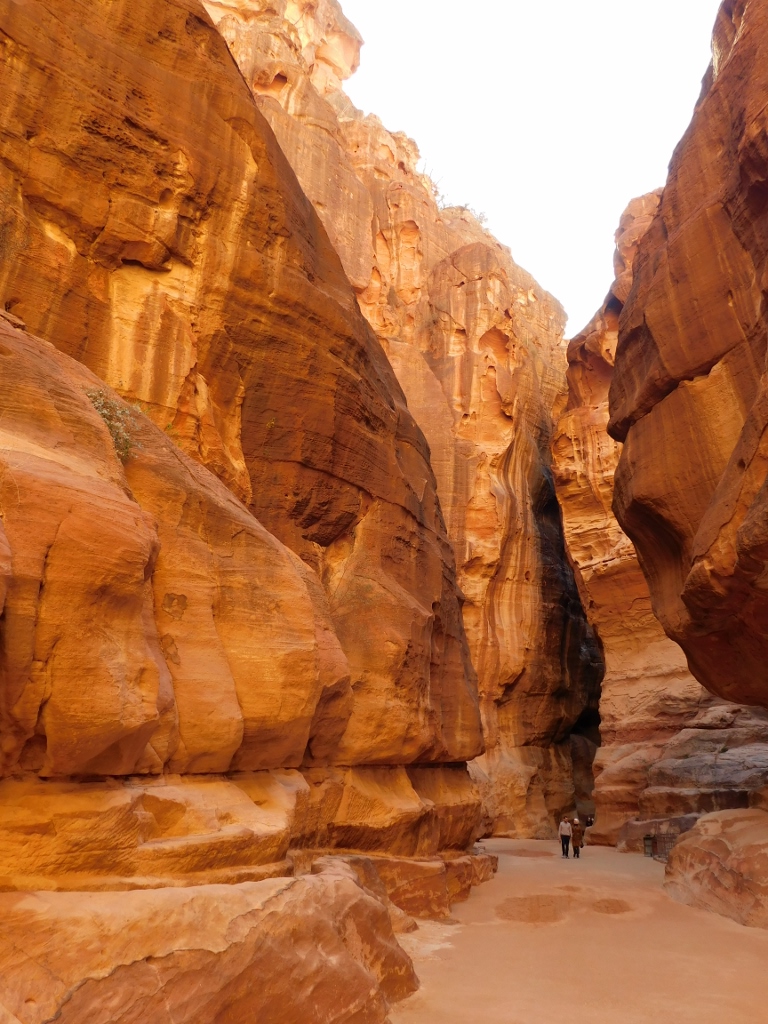 Petra, the Siq, details
Petra, the Siq, details
And then I reached the end of the Siq. I don’t think that there is any more dramatic transfer from one part of a site to another, as is the case in Petra in Jordan. Finally, after 1.2 km of walking through the impressive Siq, I could see al-Khazneh or the Treasury.
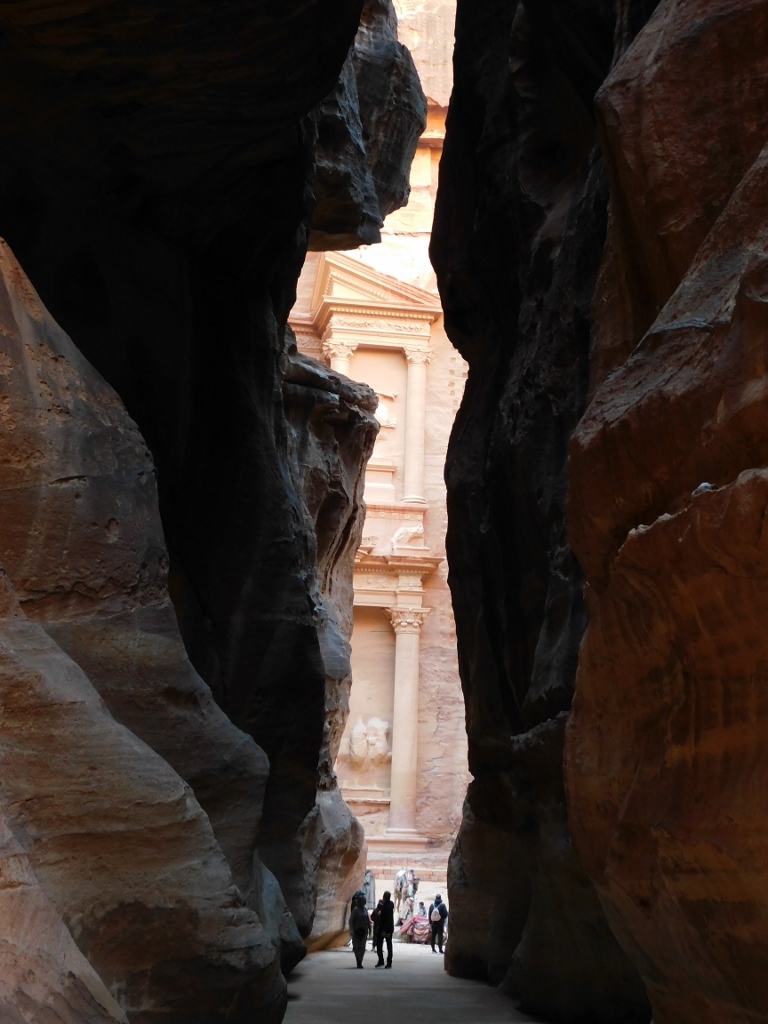 Petra, the Siq, glimpses of al-Khazneh
Petra, the Siq, glimpses of al-Khazneh
The following video shows this even better. Here it is...